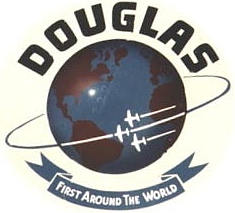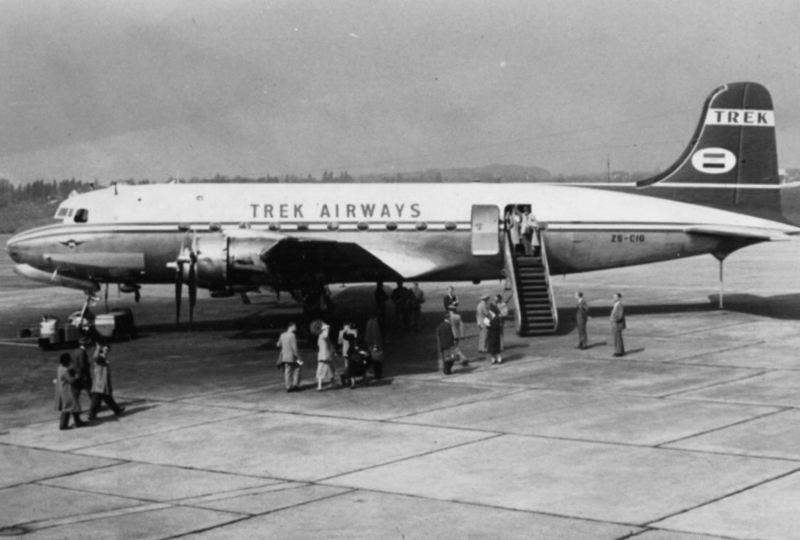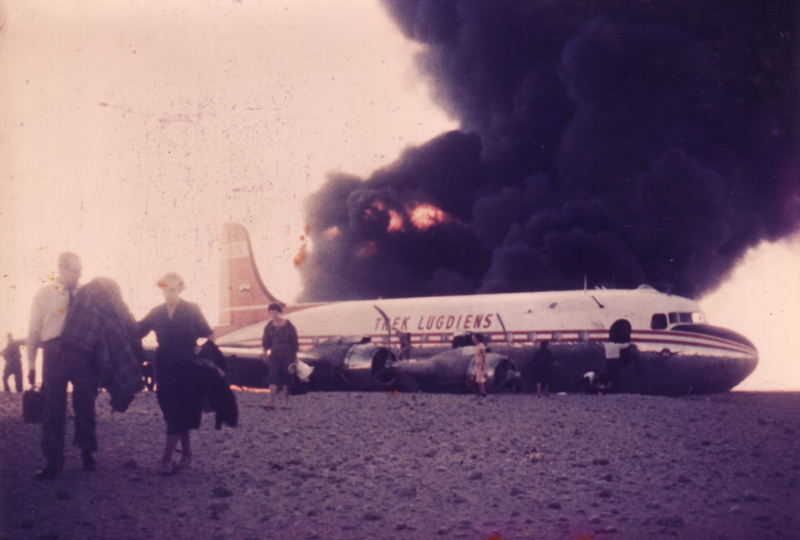
The Douglas DC-4 Association
of South Africa
Individual Aircraft History
| DC-4 South African Operators |
|
|
|
|
|
|
|
SPLIT SECOND TO
DISASTER The emergency landing of Trek Airways Douglas DC-4
Skymaster ZS-CIG c/n 42913 By: Robin H.
Anderson Captain retired. "MAYDAY -
MAYDAY - MAYDAY This is ZULU SIERRA CHARLIE INDIA GOLF - A DELTA
CHARLIE FOUR - UNCONTROLLED FIRE NUMBER TWO ENGINE -
POSITION....... On the third
day of a Trek Airways return flight from Dusseldorf, West Germany,
with Captain Tom Meredith, MD. of the airline, commanding and
Captain Ian Laatz in the left seat with myself as first officer and
Vic Francis as flight engineer, while Inge’ von Mellenthin and her
daughter Gisela, (General von Mellenthin was Field Marshall Rommel's
chief of staff in the Western Desert during WWII, and a director of
the airline.) were the two air hostesses of a DC-4 Skymaster,
ZS-CIG. Captain Meredith was returning from vacation in Europe hence
having two captains on board. We had
departed very early from Cairo International on the morning of 3rd
September 1960 on a direct flight to Entebbe on the northern shore
of Lake Victoria, Uganda. This was necessitated by the high
temperatures and large fuel load of 'Avgas' required for the ten
hour trip, putting us close to maximum all-up-weight. The previous
afternoon and night had been enjoyably spent at the Nile Hilton
Hotel on the bank of the Nile River and the passengers had been able
to visit the Pyramids and the famous Egyptian Museum not far from
the hotel, among other attractions. Because of
rising engine temperatures Vic was forced to combine with Ian in
'step-climbing' so as to cool down the motors and it took an hour to
reach cruising altitude of flight level one,zero,zero. (10,000 ft.)
As I had flown the shorter leg from Malta the day before, I was
navigating and monitoring the High Frequency radio, bearing the
brunt of lightning from all over Africa crashing in my ears. There
was no 'sellcall' in those days. Tom had meanwhile put on his
baseball cap and removed his shirt; he had well developed 'abs' and
was wont to display them to passengers visiting the cockpit! The sun
was on the other side of the plane with us flying South, so it was
not to improve his tan, which was good already! With the
aircraft 'on the step' and Vic happily reducing power for cruise I
was about to contact Cairo with a position report when I heard just
one 'ping' from the fire warning, instead of the expected,
tring,tring,tring.... I jumped up
from the little navigating table behind Tom's seat ahead of the crew
door and dashed around the radio racks and saw that #2 motor fire
warning red light was illuminated and immediately entered the cabin
to get a good look out the port passenger windows. There were flames
coming through the cowling behind the engine so I returned to stand
behind the operating crew. They had completed feathering and firing
the second CO2 bottle by this time so I reported to Tom that the
fire had burned through the nacelle in the #2 accessory drive
section, and that I was going to put out a 'Mayday call'. He
immediately concurred and Ian, who was watching the number two
engine rearwards from his sliding window said the fire was getting
worse, and nodded. Inge’ and Gisela then came rushing into the
cockpit asking Tom what they should do? He said, "Get back to the
rear and strap yourselves in!" Telling Tom
our position as just having passed East abeam Assiout on the Nile
where there was an airfield, I handed him a map of the area and
began our distress call on H.F. as above. Completing the call with
our routing, position and height I was immediately answered by
Misrair 264 on route frequency who said he had copied and would
relay to Cairo and asked for our intentions. Quickly enquiring of
Tom, I was able to advise that we were now heading 305 degrees for
an emergency landing at Assiout and that we had been unable to
extinguish the fire in a high speed dive and that our ETA was
approximately 0545Z. Misrair 264 then said, "Roger, will relay and
am standing by this frequency on 88' and 121,5." The time was 0525
Zulu. Peering out
the small round cockpit door window I could make out that the land
below was exceedingly rough with myriad eroded deep valleys, so a
landing there was out of the question. Suddenly
ZS-CIG plunged downwards and I staggered back again to behind the
pilots shouting, "Take it easy - that wing could come off!" I saw we
had just passed the edge of the escarpment and Assiout field was in
sight just across the Nile River from a village which turned out to
be Badary. Ian was looking out at what later we heard was the port
oleo hanging free from the nacelle with burnt out tyres! He said,
"I'm putting her down this side of the river!" (This turned out to
be one of the best crucial decisions made that day - the airfield
was only two miles distant. – The #2 engine with feathered blades,
would have caused burning high octane fuel to run all over on the
hard runway surface.) Immediately I
advised Misrair 264 of this new development and he indicated that
Assiout was aware of our situation and wished us Good Luck! - I
never did learn if we had been in contact with Assiout Tower on the
VHF radio! Rushing back
to look out through the windscreens I asked if they had "Briefed the
'Pax' " and Ian replied, "NO!" Grabbing the
PA 'mike' hanging behind his head, I only had time to say, "The
first impact is coming up, now BRACE - BRACE!" as we settled
smoothly towards the flat flood-water plain alongside the fields
adjacent to the river. - We were lined up with Asyut's runway in the
near distance and I could see that we had some port drift on, also
that the speed was 115 knots, and told Ian the speed. He said, "I'll
hold it off a little longer" and then told Vic to feather all four!
(Another very crucial decision, as it would have been disastrous if
the starboard fuel tanks were also ruptured by the fully feathered
propellers tearing out engines three and four as well! – Note how #3
nacelle is already bent downwards by the partially feathered blades
on that engine; just a matter of seconds before it too completed
it’s feathering cycle!) Suddenly
ZS-CIG lurched and my right leg was thrown forward onto an oxygen
bottle. For support I had been holding on to a vertical stanchion
which I was standing behind; and of course the ‘mike’! Engines
numbers one and two had been wrenched from their mounts by the
feathered propellers and rolled under the port wing, rupturing the
very nearly full fuel tanks! Soon after, we slid to a stop and I
dashed to open the cockpit door and jumped out onto the soft sand
and clambered onto the starboard wing. The
passengers had already opened the small fuselage over wing emergency
exit on my arrival and I began assisting them out and off the
sloping trailing edge of the wing. I noticed Ian outside the crew
door helping with those coming through that way and Tom in the
cockpit doorway, was handing them down. Later I had
to run to the rear emergency exit which was above my outstretched
arms to help a young man down. Telling him to stay there and help
any other passengers, I quickly returned to the over wing exit and
continued my work there. I must admit that I was non-too-gentle with
bulky people slowing down the process and there must have been quite
a few scrapes and scratches inflicted from the framework, as I
hauled on arms and legs to extricate bodies! You guessed it, I next
had to run back to the rear exit as there was no one there and
another man was about to fall headfirst from that quite considerable
height! On returning to the wing Vic had put in an appearance
alongside Ian on the ground and that helped considerably as the drop
was at least a meter to the sand. (Later it was learned that he had
clambered over the seatbacks to reach and open the main port cabin
door - fortuitously he could not do so and actually broke the handle
off trying! The fire soon spread along the fuselage to that point
and passengers eager to exit could have been badly burned, despite
the quartering wind blowing the flames from the heavily
Avgas-saturated sand away from the aircraft on that
side!) Finally no
more 'pax' presented themselves and I leant head and shoulders into
the empty cabin and shouted, "Is there anyone still inside - Is daar
enige mense nog binne?" Seeing no
one, I straightened up and made for the crew door to retrieve my
flight case - which had my logbook and money in it from changing
Egyptian currency for the passengers Northbound at a fixed rate - in
and out - so that they would not be lumbered with notes unusable
back home! (We bought the local currency in Europe at a discount and
the little extra profit made this way came in useful as our pay was
very low.) Tom stopped
me by shouting from beyond the starboard wingtip, "Andy get the hell
out of there - she's going to blow!" Now realising that the
passengers were spread willy-nilly all over, I ran towards the other
crew members shouting," ROLLCALL - ROLLCALL." Getting to where Tom
was I checked with Inge’ that there were 64 on board including a
young baby and told her to begin counting along with me. Tom then
said it would not be necessary for her to count as well and I
exploded with, "What if I'm wrong? “ – further incensed at the
unnecessary loss of my valuables! The count
tallied between us and we turned to see that the fuselage had
collapsed from the cockpit back to the tail empennage! It was found
later that the young mother had left her newborn baby behind but
another passenger had taken it to safety! A passenger told me that
from when the aircraft stopped it had taken under three minutes to
evacuate the aircraft! We could see
a truckload of troops/firemen arriving on the nearby road and Tom,
who had been given a white shirt by a man with an overnight bag, to
replace his left on his seat, and Ian, walked back to view the trail
of debris including the two engines, propellers and the port oleo
behind the Skymaster. Vic and I carried a stout lady who had injured
an ankle exiting the cockpit door in a fireman's lift - hands
holding each others' wrists - towards them. Not long
after and a crowd of villagers came rushing through our group past
the soldiers, grabbing at anything of value including my watch now
underneath my burden's bottom! Vic and I lashed out with our feet
and they left us to hurry to the wreck to salvage what they could,
even climbing onto the remaining wing full of fuel! Transported
by truck to a nearby school the passengers soon began complaining
about not being given safety instructions, but when they saw the
gaping hole in my trouser leg and I told them that we had been very
lucky to have survived what could easily have been a catastrophic
inferno, they calmed down. In assessing those hurt, Inge’, Gisela
and I found that a seat had come adrift and there was a broken
finger as well as the ankle to be attended to. Accompanied
on my request by a medical doctor who was on board to oversee our
treatment at a church hospital, we were very well taken care of by
the Sisters there. My knee received some six stitches and I was
amazed to see that it had not bled! Returning to the school we were
then conveyed to the airfield where we learnt that two DC-3s of
Misrair would be arriving to fly all but 13 of us back to Cairo. I
was to escort the volunteers by train and Ian gave us money for
tickets and food and drink. He had judiciously given his flight case
to a passenger saying, "Here, carry this," whilst still in the
aircraft! Needless to
say once on the train we were soon pretty inebriated from local
Egyptian beer; even myself, who am a teetotaler! Mrs. Charles
Fortune - whose husband of cricket commentary fame, was on one of
the DC-3s - was very entertaining with her comments. She said that
when I stopped speaking on the P.A. system I had 'frozen' on the
mike button and my laboured breathing and "Ouch" had been heard in
the cabin! This was cause for much ribbing and laughter by Vic and
others and the time passed quickly, with Vic telling us amusing
stories of his night-time escapades at the Muskey (Bazaar quarter)
in Cairo. Arriving back at the Hilton after dark we had been
preceded by the Dakota passengers who had been met by the press and
photographers. Inge’ had seen to it that we had new toothbrushes and
paste in our rooms and after a shower and delicious filet steak
room-service dinner, I slept
soundly. |
|
c/n 42913 |
 c/n 42913 |

